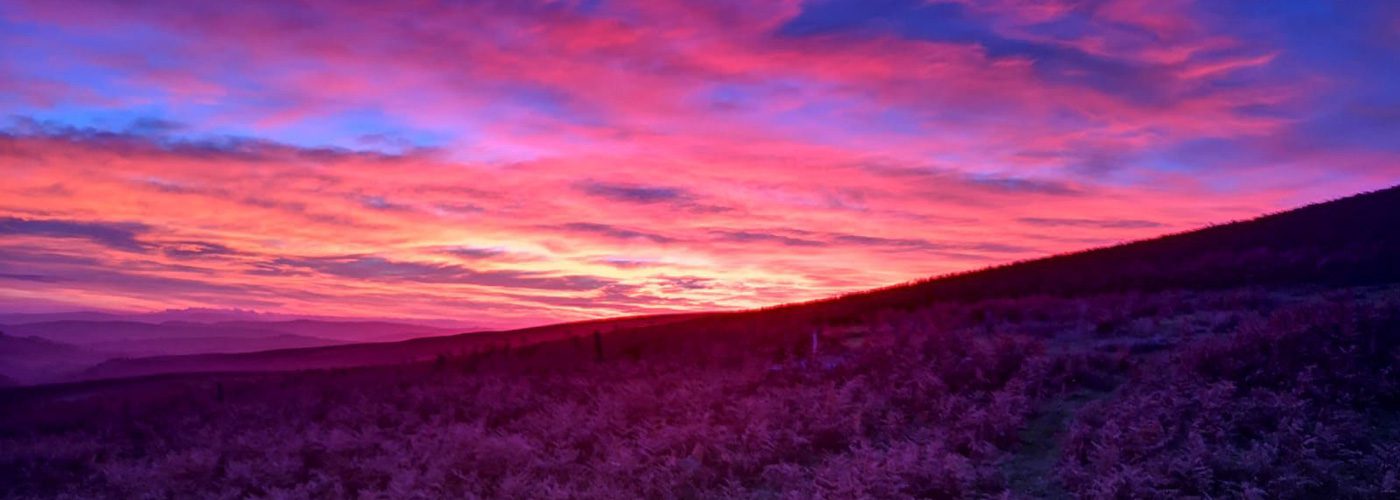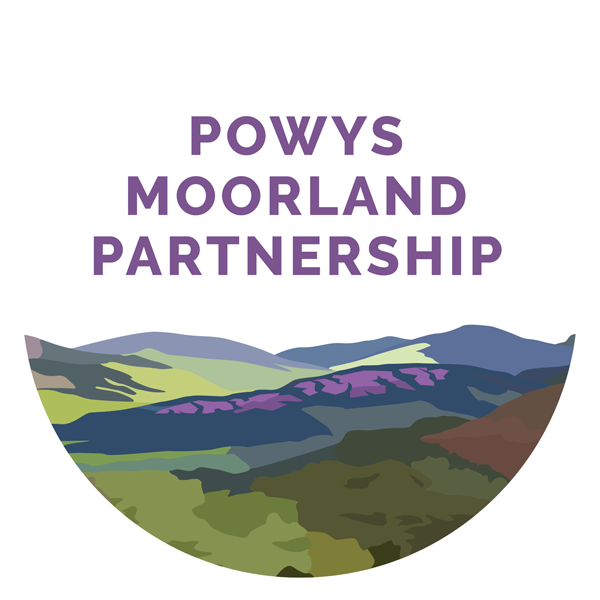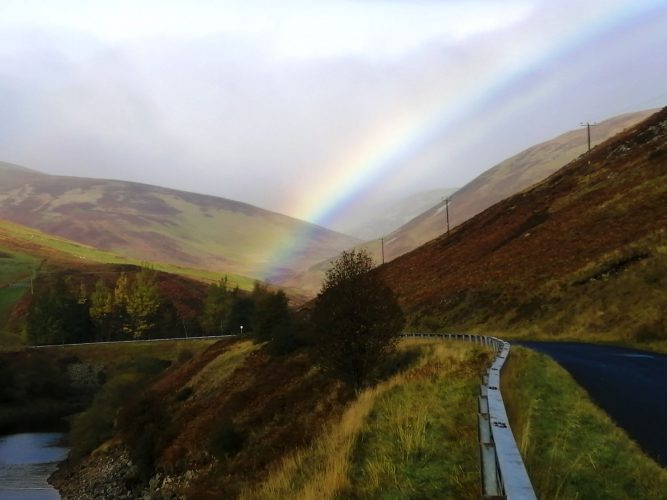In a garden, near Elan Village in Radnor, against the soundscape of the constant rustling of an Alder Tree leaves, the bleating of sheep and the occasional bumble bee, Moorland Manager David Thomas, Bird Conservationist Nick Myhill and Project Facilitator Catherine Hughes discuss and reflect on the last 3 years of the Powys Moorland Partnership SMS project – its overall performance, its achievements, some frustrations, some lessons learnt and their future hopes.
Sound recordist – Jeremy Creighton Herbert
Episode 1:
Episode 2:
Episode 3:
Powys Moorland Partnership visits the Tweed Forum
Working collaboratively at a landscape scale is something that the Tweed Forum – based on the Scottish borders with 20% of the land being North Northumberland England – has been doing for over 25 years.
From peatland restoration – which stores carbon for 1000s of years – to tree and hedge planting, pond creation, the Tweed Forum is looking at a variety of practical ways to hold back water, capture as much carbon as possible but working closely with the farmers & landowners at all times so that rural communities can play a core part of the new opportunities as they emerge.
The Scottish Government’s Climate Change plan is to restore 250,000 hectares by 2032. It also has a Land Use Strategy which is looking at balancing conservation of natural resources essential for human life. It believes that if we continue to put more pressures and demands from the land we have some difficult choices ahead if we and future generations are to continue to benefit from them.
With over 600,000 trees planted so far in the Tweed catchment along with using natural features of the landscape such as ponds and leaky barriers to reduce flood risk downstream – known as Natural Flood Management (NFM) – the Tweed Forum is getting the attention of Government and other key stakeholders across Scotland as it demonstrates its excellent relationship with the people on the ground which is critical to help reduce climate change challenges.
Through a rigorous monitoring programme conducted by Dundee university, the project will be able to test the effectiveness of their work on local towns such as Peebles, Eddleston, Hawick, Selkirk where flooding damage has cost dearly in the past.
Working with hundreds of farmers throughout the catchment, the team are fully immersed in getting the right relationship with the farmers, landowners, and getting agreed actions on the ground and working with all other users so that work is connected and coordinated and linked up sensibly. Farmer relationship is not surprisingly top priority which without their support the project simply could not connect up.
From redesigning parts of the water flow which has changed routes with some straightened over the years, along with agricultural drainage when land use was more about production, there are a variety of projects along the Tweed to look at the challenges which we all now face. The catchment has less fish, less birds, less biodiversity which calls for a different approach to see what can be restored by using the land differently through natural processes. Removal of invasive species is all part of the restoration work so that habitats can be created or come back to life, but ultimately the aim is to raise the ecological status of the river by generating solid evidence of the impact, cost and benefits of working with natural processes at a catchment scale.
With similarities of how the landscapes look visually between here and mid Wales along with the same issues of loss of biodiversity, failing water quality, struggling rural communities, increase risk of flooding downstream, we believe there are huge opportunities to adopt similar approaches to the Tweed Forum to restore our habitats and find out what approaches could slow down the effects of climate change and what new opportunities might emerge as a result.
We have a lot to learn but mistakes are important to notice and maybe we can fast track to the best easier wins from the wealth of experiences from the Tweed Forum, but more importantly maybe is getting key stakeholders to agree a vision on our landscape and that all takes time.
Catherine Hughes, Powys Moorland Partnership facilitator
The collaborative approach to moorland management
Wales has two million hectares of moorland. In the coming years managing these areas is going to be a challenge, but with imagination and collaboration new approaches should ensure that they thrive for generations to come.
This is the message that we at Powys Moorland Partnership (PMP) are committed to take to the moorland communities of Wales as we set out on a three year project to discuss, listen and create with residents a new vision that will promote a thriving, sustainable environment and economy using local solutions.
Issues that we have so far identified include:
- How to manage habitats positively with conservation grazing
- How to reduce the demand on fuel
- How to minimise the risk of wildfires
But what might our moorlands look like in the future, and how would we like them to evolve? We don’t have the answer yet, which is why we’ll be talking to as many stakeholders and residents as possible in the coming months, to shape the approach that we take.
We hear much talk of topics such as the reintroducing mammals into the forests close to our moorland. These grab media headlines, but ignore the true complexity of management of this unique countryside.
It will be crucial for us to encourage the public enjoyment of these landscapes, whilst managing them and creating revenue streams that enable the areas to pay for themselves. Meanwhile, we have to consider how to create profitable economic opportunities that enhance the moorlands rather than harming them.
As Black Mountains resident and rural commentator Rob Yorke said recently during PMP’s Talk on the Wildside event at the Globe at Hay on Wye (18th October 2017) “…this was never going to be easy.” Rob argues that managed landscapes have to be preferable to wilderness, although the scale of management is up for debate – particularly with unregulated common land forming a substantial part of our moorland environment.
“Creating economic opportunity has to be a major consideration,” he adds. “Surely a mix and private and public funding has to be part of the solution. And what about sheep farmers? It’s difficult to be green when you are in the red.”
Funded by the Welsh Government and the EU under the Rural Development Programme, Powys Moorland Partnership (PMP) will focus on integration, balancing the needs of all parties, while remembering that these landscapes are a crucial resource for the country. For example, millions of tons of carbon are stored in them while 70% of Wales’ drinking water is sourced there.
Sue Evans, the director in Wales for the Game & Wildlife Conservation Trust, stressed the need for scientific evidence to support sustainable conservation practice in the future.
“The countryside needs paying for and we need to look at all the options that are out there and what new partnerships can be formed to attract new investment,” she says, adding that the loss of biodiversity through habitats and key iconic birds such as the curlew is well documented.
“Good conservation goes hand-in-hand with economic land use and now is the time to demonstrate what actions could be positively embraced on the Powys Moorland Partnership over its three-year lifetime.”
For further information please contact Catherine on 07815 103855 or email catherine@thebridgehay.co.uk
Keep in touch, get involved.
We will be putting on various events over the next 12 months. If you would like to get involved, have some ideas please contact Catherine on urmyc.sdnalroomsywop@tcatnoc


